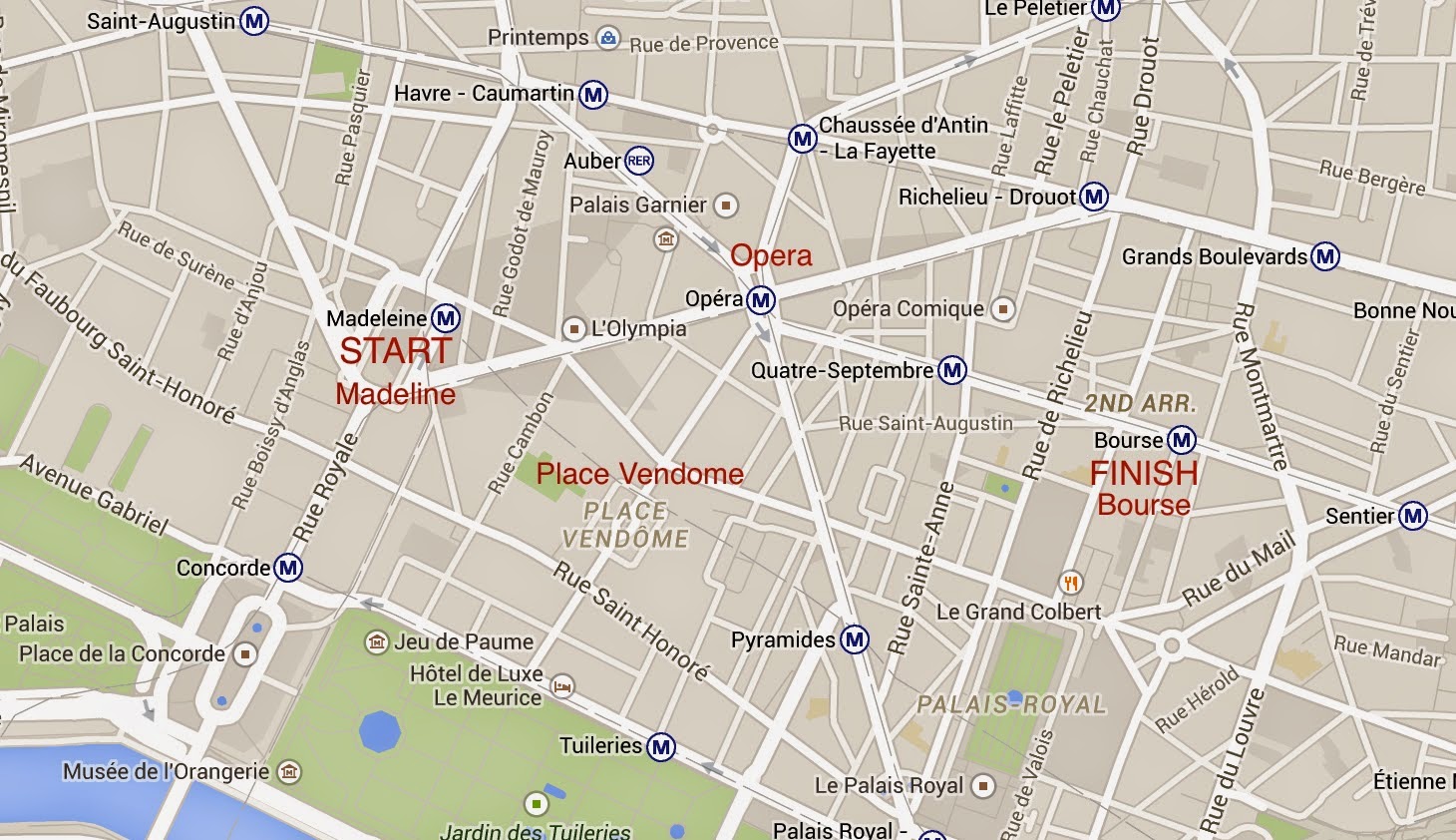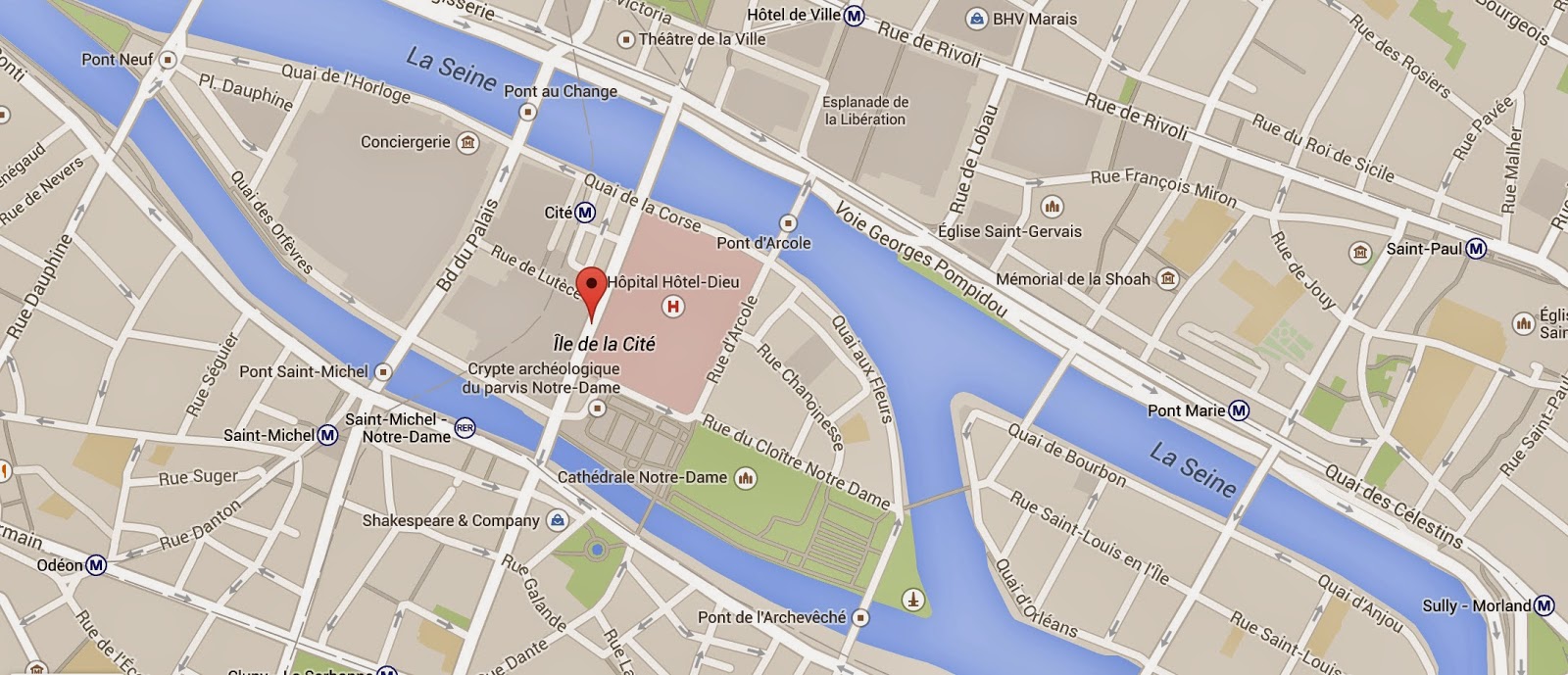You've probably read about the different attractions in Paris, but what you won't know is how to get around the city to those attractions. Sure, you can take dumpy side streets to get to the Eiffel Tower or wherever, but there are much nicer routes that connect these attractions to each other. Also, there are other parts of Paris you want to avoid, especially at night (around Montmartre, Bois de Boulogne, Moulin Rouge, Barbes-Rochechouart, and Pigalle). These are some good walks to take that can connect you between attractions. When in Paris, I would plan out a route --for example, the Louvre to the Arc du Triomphe-- and then take the Metro back. This can also depend on the location of your hotel, so keep that in mind when planning walks.
1) Louvre - Tuileries Gardens - Place de la Concorde - Champs-Elysées - Arc du Triomphe
Distance: 3.3km Walking Time: 40-50 mins Time/Interest Rating: 2.4/3
Awesomest Moment: When you're standing at the Arc du Triomphe du Carousell and see the Egyptian Obelisk in the distance, and behind that, the Arc du Triomphe, all perfectly centred.
 Brief Description:
Brief Description: This is a great walk if you want to see the Axe Historique all at once. (The Axis is the string of historic landmarks and monuments in an almost straight line towards the northeast. If you do one walk in Paris, this is it: After you look in the Louvre, head towards the
 |
This picture shows the perspective of the
Axe Historique. |
Arc du Triomphe du Carrousel (basically a mini Arc du Triomphe). Then, relax in the Tuileries Gardens and try not to get pickpocketed by the overly affectionate pigeons. From there, charge through the Place de la Concorde, but get across the roundabout before you look at the lovely Egyptian Obelisk. Getting run over is not a good way to start your walk. Then, make your way up the Champs- Elysées. The first third or so is tree covered, but not super interesting. Consider finding a Metro station to get closer to the Arc de Triomphe if you don't want to walk the whole way. (The
Champs-Elysées Clemenceau,
Franklin D. Roosevelt, and
George V. stations are all positioned along the Champs-Elysses. Most of the interesting stores are between the
Franklin. D. Roosevelt and
George V. stations, and the
Champs-Elysées Clemenceau station is located 2/3 of the way down the tree covered section.) Of course, the Arc du Triomphe is breathtaking as it gradually comes into view.
2) Musée d'Orsay - Esplanade des Invalides - Tour Eiffel
Distance: 2.5km Time: 30-40 mins Time/Interest Rating: 2.5/3
Awesomest Moment: The moment when you get your first real glance of the Eiffel Tower, and wonder how you could have possibly missed it before... it's actually quite difficult to see until you pass Les Invalides!
 Brief Description:
Brief Description: This walk is a fun way to get to the Eiffel Tower (see the earlier blog post about it.) If you want to approach from the Champ de Mars side of the Eiffel Tower, this is a good way to incorporate it into your day. I would highly recommend going into the Musée d'Orsay, even if you're only there for an hour or two. From the Musée d'Orsay, follow the Quai Anatole France until it merges into the Quai d'Orsay. This boulevard is rather busy, but it is shaded. Enjoy the fabulous views of the Seine river as you walk along its banks. About five minutes from Les Invalides, you'll see the
Palias Bourbon, an 18th century parliamentary mansion. You'll pass the Air France base before you see the golden dome behind the Musée d'Histoire Contemporaine. (Add a 6 minute walk if you want to get closer to Les Invalides and the museum.) If you're getting tired of walking, find the Invalides Metro station and take it to Ecole Militaire. If not, you have two choices:
1) Continue on the Quai d'Orsay, which later becomes the Quai Branly. This will take you right to the Eiffel Tower. (It is rather hard to miss...)
2) Continue on the Quai d'Orsay until you get to the Pont de l'Alma (no, not the llama bridge!) and then turn down the Avenue Rapp or the Avenue Bosquet. Both streets will take you to the
Champ de Mars, from where you can walk to the Eiffel Tower. Avenue Bosquet will take you longer, since you'll have to walk the entire length of the Champ de Mars to get to the tower.
3) Madeleine - Place Vendôme - Opera - Bourse
Distance: 1.9km Time: 20-30 mins Time/Interest Rating: 2.7/3
Awesomest Moment: Watching the tourists go into the super expensive shops in Place Vendome, and then seeing them come out with bewildered looks on their faces: "$680 for a
perfume??"
Brief Description: This is another awesome walk in central Paris. Start at the Place de Madeleine, where you'll see the BIG temple. (Of course, dedicated to the glory of Napoleon's army.)
 |
The Place Vendôme Column from a distance...
watch out for cars! |
It's startlingly similar to the Maison Carée in Nimes, only a lot larger. From there, you can walk down the Boulevard de la Madeleine, then the Rue des Capucines until you find the Place Vendôme. This is where some of the most expensive shops in Paris are. When you see a Chanel store and a Louis Vuitton store right next to each other, you know you're in an expensive shopping area. There's a big column right in the middle of the Place Vendôme, although it is currently under construction. From there, take
Rue de la Paix to the Opera, where you can marvel at the awesomeness of the Paris Opera House. (You can take a tour inside it, but I'll save that for a later blog post. After the Place de l'Opera, walk along the Rue du Quatre Septembre until you get to the Bourse Metro Station. The square is nothing special, but on Rue Vivienne (nearby) you'll notice a restaurant called Le Vaudeville. You MUST eat a meal here. It's expensive, but their smoked salmon is probably the best thing you have ever tasted. If you can't afford the (possibly) 40 euro per person cost, well... there's a Monoprix down the street *sighs*.
4) Notre Dame - Musee de Cluny - Sorbonne University - Luxembourg Gardens
Distance: 1.3km Time: 15-25 mins Time/Interest Rating: 2.2/3
Awesomest Moment: Just after the bridge that gets you off Ile de la Cité, you'll have the opportunity to go down the narrowest street in Paris...1.8m wide Rue de Chat Qui Pêche. It's located just off the Quai Saint-Michel.
Brief Description: If you want to see the Luxembourg Gardens and the Notre Dame Cathedral in one day, this is an excellent option if you don't want to take the Metro. (
Note: If you want to do a more thorough exploration of the islands, I would not try to cram this walk into that day. Spend a whole
day exploring the islands, and tie this walk into an exploration of the area around the Luxembourg Gardens instead.) Starting at the Notre Dame Cathedral, walk across the Petit Pont, then follow the Rue du Petit Pont. It will eventually turn into the Rue Saint-Jaques, and three blocks past that point you will come across the Cluny Museum. It's full of Medieval art, located in a Gothic mansion. It's definitely not for everyone, and if you only have a few days in Paris, don't bother with it. If you're into Medieval stuff (which I'm not), you would probably find it interesting. After you pass the museum, you'll come across the Sorbonne Univeristy. Out of all the streets in this area,
 |
In the depths of the Luxembourg Gardens, the Luxembourg Palace is...
well, not exactly hidden. |
Rue des Écoles is the nicest. The others aren't spectacular or anything, but it gives you a taste of the Parisian lifestyle. As a general rule, stick to larger streets-- they are tree-covered, have large sidewalks, crosswalks, and are generally not sketchy. This is a pretty safe area, though, and you can explore any of the side streets, and... what are those trees over there? You've already arrived at the Luxembourg Gardens! These meticulously tended gardens are absolutely awesome, so enjoy a walk in the early afternoon or evening here.
I hope you enjoyed reading about these walks in Paris! If you find yourself in Paris, maybe you'll try out one of these walks. Walking to different attractions instead of taking the Metro is a great way to save money, get a taste of Parisian life, and have a good adventure!
(The most adventurous thing that can happen to you in the Metro is getting your jacket stuck in the turnstiles. Trust me, it happens...)
There's more!
Blog posts relating to these locations:
- Make the Most of Le Tour Eiffel (all about the Eiffel Tower and Champ de Mars)
- Islands on the Seine (Explains Île de la Cité, Notre Dame Cathedral, etc)
Soon to come...
- Gardens in Paris: Tuileries & Luxembourg
- The Paris Opera House
 Location: Just south of Sorbonne University, in the 6th Arrondissement.
Location: Just south of Sorbonne University, in the 6th Arrondissement.












































